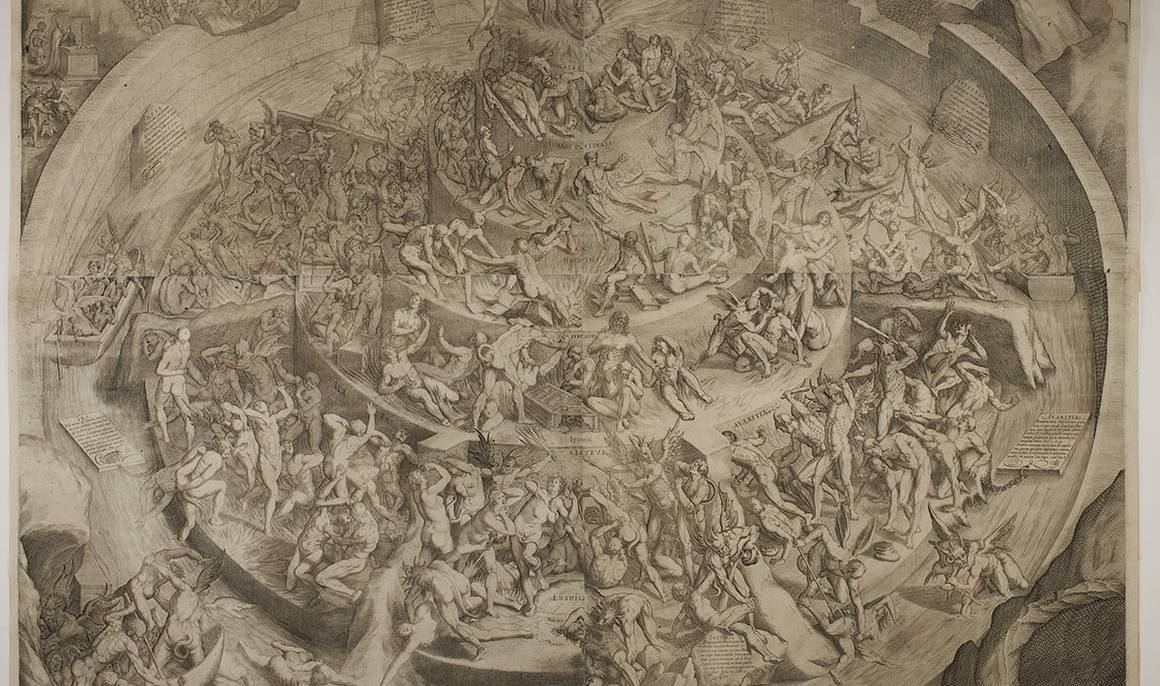The Dante-Esque Topography: Fantastic Maps of the Divine Comedy
Dante’s work has been reimagined and re-presented by artists almost since its first publication.
The Divine Comedy of Dante Alighieri remains one of the most important literary works in history. The poet speaks of a journey through the levels of hell, limbo, and paradise, and in addition to giving titles to each of the three parts of the poem, it transports readers through the worldview of the 13th century through the characters and obsessions of the time.
Dante embarks on the journey guided by the poet Virgil. Virgil shows him the nine circles of hell, where souls get no rest but are condemned to repeat their sins again and again, albeit allegorically. Each of the circles represents a different method of torment, depending on the sins that were committed in life. Torments range from the very light, such as dying without having been baptized (Dante’s Florence, was very much under the dominion of the Catholic Church), to the most unusual of betrayals.
Both the use of the three canticas (that is, in the very structure of the poem) to the disposition of souls at the levels of the underworld, are designed as a response to both theological considerations and to the very European obsession with mapping and shaping the world. This obsession applied to both visible and invisible aspects of the world. Although an underworld existed in classical Greek mythology, “Hades” means, literally, that which cannot be seen. In the Christian view, heaven and hell are arranged according to a theological rationality that tried to avoid misunderstandings as to the destiny of souls, in this world and in the next.

It’s no coincidence that in the following centuries (during European expeditions to the rest of the world), cartography and map-making will be of tremendous relevance. Artists and geographers set themselves to the task of delineating and representing the places described by Dante, and this gave rise to wonderful works of art. Antonio Manetti’s “Section, Plan, and Dimensions of Dante’s Inferno” is one example. Boticelli’s extraordinary inverse cone in his “Map of Hell” is another. Even Galileo presented his conclusions as to the dimensions of an inferno.
Finally, any map of the places described by Dante can’t be understood without the religious context in which the work is inscribed. The Divine comedy has very little comedy in the modern sense of the word. The classical comedy always ends with an “elevation,” real or spiritual, in its characters. This could be the result of a fruitful business deal, a marriage, or a victory, but it’s the opposite of a tragedy, where the outcome is dismal. The very title of this work warns us that we’re in for an elevation (Dante’s route to Paradise, where the lady, Beatriz, will, in turn, present the levels of heaven and its legions of angels). To complicate things a little more, Dante needs to go down to the bottom of hell to be worthy in his rise to the higher levels. It’s an authentic odyssey that was to foretell of the fantastic voyages of many subsequent centuries.




A Hell map from an edition of Divine Comedy printed in the late 15th century by Aldus Manutius, 1515

*Images: Public Domain
Related Articles
Pictorial spiritism (a woman's drawings guided by a spirit)
There are numerous examples in the history of self-taught artists which suggest an interrogation of that which we take for granted within the universe of art. Such was the case with figures like
Astounding fairytale illustrations from Japan
Fairy tales tribal stories— are more than childish tales. Such fictions, the characters of which inhabit our earliest memories, aren’t just literary works with an aesthetic and pleasant purpose. They
A cinematic poem and an ode to water: its rhythms, shapes and textures
Here lies One Whose Name was writ in Water. - John Keats Without water the equation of life, at least life as we know it, would be impossible. A growing hypothesis holds that water, including the
Watch beauty unfold through science in this "ode to a flower" (video)
The study of the microscopic is one of the richest, most aesthetic methods of understanding the world. Lucky is the scientist who, upon seeing something beautiful, is able to see all of the tiny
To invent those we love or to see them as they are? Love in two of the movies' favorite scenes
So much has been said already, of “love” that it’s difficult to add anything, much less something new. It’s possible, though, perhaps because even if you try to pass through the sieve of all our
This app allows you to find and preserve ancient typographies
Most people, even those who are far removed from the world of design, are familiar with some type of typography and its ability to transform any text, help out dyslexics or stretch an eight page paper
The secrets of the mind-body connection
For decades medical research has recognized the existence of the placebo effect — in which the assumption that a medication will help produces actual physical improvements. In addition to this, a
The sea as infinite laboratory
Much of our thinking on the shape of the world and the universe derives from the way scientists and artists have approached these topics over time. Our fascination with the mysteries of the
Sharing and collaborating - natural movements of the creative being
We might sometimes think that artistic or creative activity is, in essence, individualistic. The Genesis of Judeo-Christian tradition portrays a God whose decision to create the world is as vehement
John Malkovich becomes David Lynch (and other characters)
John Malkovich and David Lynch are, respectively, the actor and film director who’ve implicitly or explicitly addressed the issues of identity and its porous barriers through numerous projects. Now










